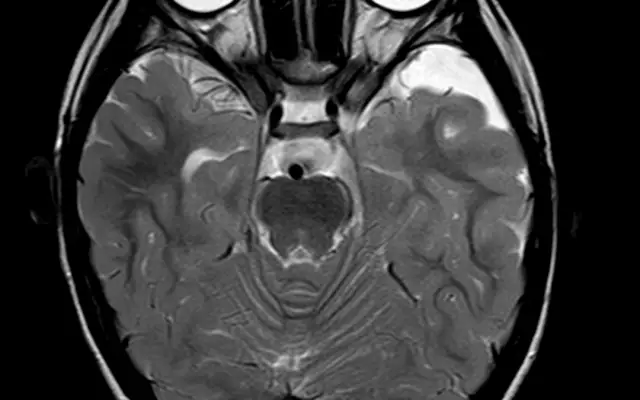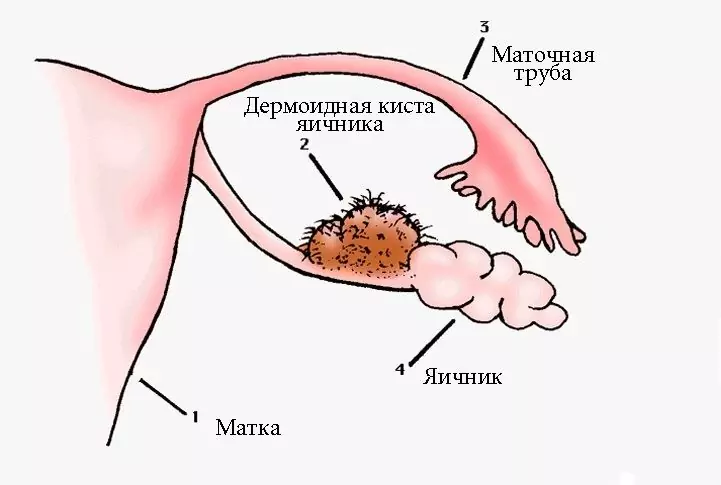- Author Rachel Wainwright [email protected].
- Public 2024-01-15 19:51.
- Last modified 2025-11-02 20:14.
Spleen cyst
The content of the article:
- Classification and pathomorphology
-
Spleen cyst: causes of development
- Congenital
- Acquired
- Symptoms
- Possible complications
- Diagnostics
-
Spleen cyst treatment without surgery
- Conservative treatment
- Sclerotherapy
- General recommendations
- Surgery
- Forecast
- Prevention
- Video
A spleen cyst is a neoplasm, which is a pathological cavity in the parenchyma of an organ. A capsule delimits the cystic formation from healthy tissue, the cavity is filled with liquid contents. According to statistics, this pathology occurs in about 1% of the population.
In about 50% of cases, cystic formation is discovered by chance during a preventive medical examination or diagnosis for another reason.

Spleen cysts are of several types, the approach to treatment depends on the type
Classification and pathomorphology
Cystic formations can be congenital and acquired, single and multiple, unicameral and multi-chambered.
The fluid that fills the cystic cavity can be serous or hemorrhagic (in the presence of blood impurities).
There are the following types:
| View | Subspecies |
| True (solitary) |
· Simple; · Multi-chamber cystadenoma; · Retention; Dermoid. |
| False |
· Inflammatory; · Traumatic. |
| Spleen ligament cyst | - |
By origin, cystic formations of the spleen are divided into three groups, which are presented in the table.
| Type of neoplasm | Description, pathomorphology |
| True cyst |
Formed in the prenatal period of development, the pathological cavity is surrounded by a capsule, the inner wall of which is lined with endothelium |
| False cyst | Refers to acquired formations, has a capsule of connective tissue |
| Parasitic cystic formation | Formed when parasites enter the organ |
Spleen cyst: causes of development
The spleen is the largest lymphoid organ in vertebrates, which is located in the abdominal cavity and has a convex diaphragmatic and concave inner surface. Most often, cystic formations of this organ develop in females aged 35-55 years (in women, 3-5 times more often than in men).
Congenital
One of the causes of the pathology is anomalies in the development of the spleen in the prenatal period. So, this can happen if a pregnant woman has bad habits, when she uses a number of medicines, or if the body is exposed to unfavorable environmental factors.
Acquired
Acquired cystic formations can be a complication of an abscess, spleen infarction, occur after surgical interventions (removal of part of an organ by surgery, excision of a pathological formation), injuries (bruises, wounds of the abdominal cavity). Pathology can develop after suffering from influenza, typhoid fever and a number of other infectious diseases.
Cystic cavities can occur with parasitic diseases (infection with echinococcus, pork tapeworm). Once in the spleen, helminths are able to form cystic cavities in its tissues. The emergence of parasitic cystic formation can be facilitated by eating unwashed fruits and vegetables, meat that has not undergone sufficient heat treatment.
Symptoms
If the patient has small neoplasms, there are no signs of pathology.
With an increase in the cystic cavity and / or the development of several cysts, patients may experience:
- nausea and vomiting;
- belching;
- pain in the left hypochondrium, which can radiate to the scapula, left arm;
- weakness and fatigue;
- headache;
- dizziness;
- discomfort and heaviness (feeling of fullness) in the left hypochondrium after eating;
- shortness of breath, dry cough, discomfort, tingling in the chest with a deep breath.
Abdominal pain can be persistent or paroxysmal. As the cystic mass increases, the intensity of the pain increases. Splenomegaly, abdominal distension, diarrhea, or constipation are common in multiple lesions and / or when the cyst is large (about 7 cm in diameter).
When an infectious-inflammatory process joins, patients experience chills, fever, and weakness.
Possible complications
One of the possible complications is cyst suppuration. In this case, there is a possibility of developing sepsis.
In case of mechanical damage, rupture of the cystic formation and the outflow of its contents into the abdominal cavity is possible, which can lead to peritonitis and death. Also, if a neoplasm ruptures, internal bleeding may develop.
Diagnostics
In the absence of clinical signs, pathology is usually diagnosed incidentally. With large cysts, during an objective examination, the doctor may suspect its presence, however, instrumental diagnostics is required to confirm the diagnosis:
- Ultrasound examination (ultrasound) - true cysts look like a rounded anechoic formation with a clear outline, false - a rounded neoplasm with a pronounced capsule and signs of calcification of the wall, parasitic ones look like nodes of an irregular shape with pronounced calcification of the wall.
- Multispiral computed tomography (MSCT) - allows you to determine the exact size, location of the cystic formation and its interaction with surrounding tissues.
For the purpose of differential diagnosis with benign and malignant neoplasms of the spleen, a biopsy is performed. If a neoplasm is suspected of a parasitic nature, serological studies are carried out.
Spleen cyst treatment without surgery
In some cases, the disease does not require treatment, expectant tactics are indicated. For example, congenital cysts are able to resolve on their own after a while. These patients usually require dynamic ultrasound guidance, which involves an ultrasound scan 1-2 times a year. Also, such monitoring is recommended for patients with a history of spleen surgery.
Conservative treatment
Depending on the cause of the development of the pathological process and the existing symptoms, the patient may be prescribed antibacterial drugs, anti-inflammatory, antipyretic, anthelmintic drugs, etc. Drug therapy is aimed at eliminating the symptoms, but with respect to the cyst itself, it is practically ineffective.
Sclerotherapy
Treatment of a cyst by percutaneous puncture under ultrasound control is possible when its size is up to 5 cm in diameter, if the formation is located subcapsularly along the diaphragmatic surface of the spleen. After aspiration (pumping out) of the liquid contents of the cyst, a special drug is injected into the cavity - sclerosant - a substance that causes adhesion of the cystic walls. Re-procedure may be required.
General recommendations
Patients who have a cystic formation are not recommended to engage in traumatic sports. After surgery, it is recommended to avoid excessive physical exertion for 2-3 months.
Patients do not need to follow a special diet. After the operation to remove the spleen cyst, it is recommended to limit the use of heavy, fatty foods, the exclusion of alcoholic beverages. It is advisable to include more whole grains, vegetables and fruits in the diet.
Surgery
An operation may be necessary in the presence of a pronounced clinical picture (disturbances from the organs of the gastrointestinal tract, constant pain in the left hypochondrium, etc.), also with a recurrent course of the disease (4 episodes per year or more).
The absolute indications for surgery are:
- rupture of the cyst capsule;
- the occurrence of an abscess;
- the development of bleeding;
- detection of one large (more than 10 cm in diameter) or several small (more than 5) cystic neoplasms of the spleen.
The most popular methods of surgical removal of cystic formation include laparoscopy - a low-traumatic and effective method that has a shorter recovery period in comparison with abdominal operations. If laparoscopy is contraindicated for one reason or another, open access surgery (laparotomy) is performed.

With severe manifestations of the disease, surgical treatment is required
Types of operations:
| Operation | Explanation |
| Cystectomy | All or most of the cyst with membranes is removed, and the remainder is treated with argon to reduce the risk of recurrence. Excision of the walls of the cystic formation without resection of the spleen makes it possible to practically not disrupt its function. |
| Partial resection of the spleen (removal of the affected area) | It is indicated when one medium-sized formation or several small cystic cavities are detected. |
| Total resection, or splenectomy | It is indicated when the patient has more than 50% of the organ area affected. If it is impossible to preserve the spleen, autotransplantation of the patient's spleen tissue into the greater omentum may be recommended, which makes it possible to partially preserve the immunological properties of this organ. |
The biological material obtained during the operation to remove the cyst is usually sent for histological examination.
Forecast
The prognosis depends on the location of the cystic cavity, its size, and the presence of complications. With a small single neoplasm, the prognosis is favorable. An increase in cysts in size, the development of complications can lead to the occurrence of life-threatening situations.
Prevention
In order to prevent the development of the pathological process, it is recommended:
- regularly undergo preventive medical examinations;
- timely treat diseases that can lead to the appearance of cystic formations;
- observe the rules of personal hygiene;
- to refuse from bad habits;
- improve immunity.
Video
We offer for viewing a video on the topic of the article.

Anna Aksenova Medical journalist About the author
Education: 2004-2007 "First Kiev Medical College" specialty "Laboratory Diagnostics".
The information is generalized and provided for informational purposes only. At the first sign of illness, see your doctor. Self-medication is hazardous to health!






